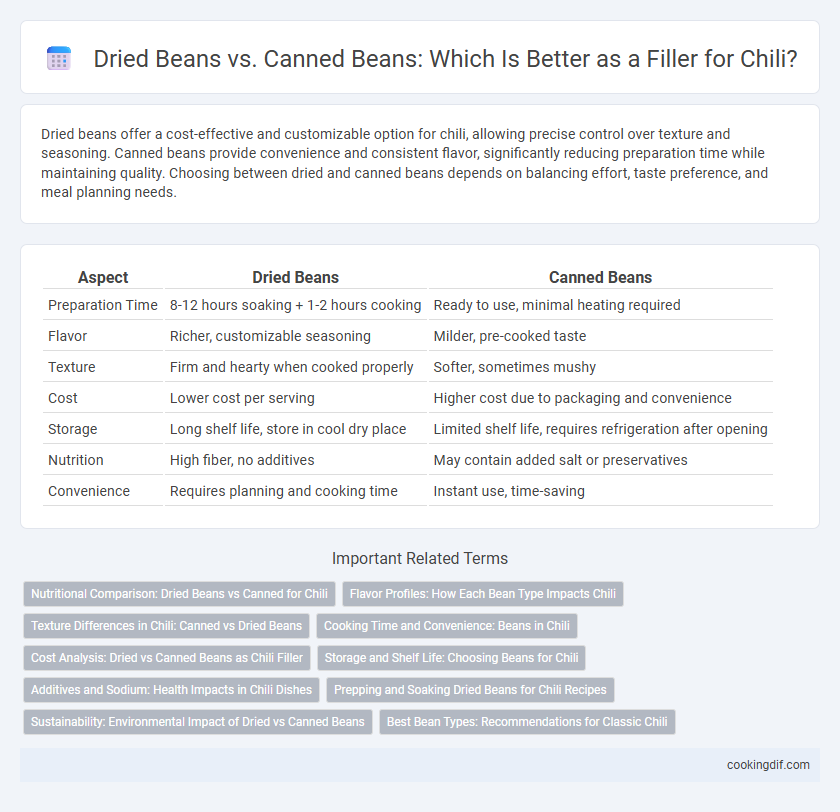Dried beans offer a cost-effective and customizable option for chili, allowing precise control over texture and seasoning. Canned beans provide convenience and consistent flavor, significantly reducing preparation time while maintaining quality. Choosing between dried and canned beans depends on balancing effort, taste preference, and meal planning needs.
Table of Comparison
| Aspect | Dried Beans | Canned Beans |
|---|---|---|
| Preparation Time | 8-12 hours soaking + 1-2 hours cooking | Ready to use, minimal heating required |
| Flavor | Richer, customizable seasoning | Milder, pre-cooked taste |
| Texture | Firm and hearty when cooked properly | Softer, sometimes mushy |
| Cost | Lower cost per serving | Higher cost due to packaging and convenience |
| Storage | Long shelf life, store in cool dry place | Limited shelf life, requires refrigeration after opening |
| Nutrition | High fiber, no additives | May contain added salt or preservatives |
| Convenience | Requires planning and cooking time | Instant use, time-saving |
Nutritional Comparison: Dried Beans vs Canned for Chili
Dried beans contain higher fiber and lower sodium levels compared to canned beans, making them a healthier choice for chili. Canned beans often include preservatives and added salt, which can increase sodium intake and affect heart health. Cooking dried beans allows control over seasoning and texture, enhancing the nutritional profile of the chili.
Flavor Profiles: How Each Bean Type Impacts Chili
Dried beans develop richer, earthier flavors through slow cooking, enhancing chili's depth and authenticity, while canned beans offer a milder, less complex taste that can dilute the chili's intensity. The texture of dried beans becomes creamier and more velvety, providing a satisfying bite that complements robust spices commonly used in chili recipes. Using dried beans allows for full absorption of chili seasoning, resulting in a harmonious flavor profile, whereas canned beans may introduce excess sodium and preservatives that subtly alter the dish's natural taste.
Texture Differences in Chili: Canned vs Dried Beans
Dried beans in chili offer a firmer, creamier texture after slow cooking, absorbing flavors while maintaining shape, which enhances the overall mouthfeel. Canned beans tend to be softer and sometimes mushy due to pre-cooking and can release starches that thicken the chili but reduce bean integrity. Choosing dried beans allows greater control over texture, while canned beans provide convenience with a softer consistency.
Cooking Time and Convenience: Beans in Chili
Dried beans require soaking and longer cooking times, often several hours, which can significantly extend chili preparation but offer a fresh texture and enhanced flavor absorption. Canned beans provide immediate convenience, reducing cooking time by being pre-cooked and ready to use, making them ideal for quick chili recipes. Choosing between dried and canned beans for chili depends on balancing preparation time with desired texture and flavor intensity.
Cost Analysis: Dried vs Canned Beans as Chili Filler
Dried beans cost significantly less per serving compared to canned beans, making them a budget-friendly option for chili filler. Though canned beans save time and effort due to their pre-cooked nature, their higher price per unit weight impacts overall recipe costs. Bulk purchasing of dried beans combined with minimal preparation can maximize cost savings without compromising chili quality.
Storage and Shelf Life: Choosing Beans for Chili
Dried beans offer a longer shelf life, often lasting up to two years when stored in a cool, dry place, making them ideal for long-term storage and bulk purchase. Canned beans provide convenience with a shelf life of about 1 to 2 years but require refrigeration after opening and cancontain added sodium or preservatives. For chili, dried beans allow better control over texture and flavor, while canned beans are time-saving with consistent results.
Additives and Sodium: Health Impacts in Chili Dishes
Dried beans provide a cleaner option for chili dishes by minimizing exposure to additives and excess sodium commonly found in canned beans, supporting heart health and better blood pressure control. Canned beans often contain preservatives, added sodium, and sometimes sugar, which can elevate sodium intake beyond recommended limits, potentially exacerbating hypertension and fluid retention. Choosing dried beans allows for precise control over seasoning and sodium levels, enhancing nutrient density and promoting better overall health outcomes in chili recipes.
Prepping and Soaking Dried Beans for Chili Recipes
Dried beans require thorough soaking, typically 8 to 12 hours, to reduce cooking time and enhance digestibility, making them ideal for hearty chili recipes where texture and flavor depth are priorities. Canned beans offer convenience with pre-cooked softness and immediate use but may lack the concentrated flavor and firmer bite provided by properly soaked and cooked dried beans. Selecting dried beans also allows control over sodium content and firmness, essential for customizing chili's texture and nutritional profile.
Sustainability: Environmental Impact of Dried vs Canned Beans
Dried beans have a significantly lower environmental impact compared to canned beans due to reduced energy consumption in processing and transportation, as they require less packaging and can be stored without refrigeration. Canned beans involve higher carbon emissions from manufacturing metal cans and maintaining cold supply chains, adding to overall sustainability concerns. Choosing dried beans supports waste reduction and conserves resources, making them a more eco-friendly option for chili recipes.
Best Bean Types: Recommendations for Classic Chili
For classic chili, dried beans such as pinto, black, and kidney beans offer superior flavor and texture compared to canned beans. Pinto beans provide a creamy consistency, black beans contribute a rich, earthy taste, and kidney beans hold their shape well for hearty chili. Using dried beans allows for better control over seasoning absorption and overall dish quality.
Dried beans vs canned beans for filler Infographic

 cookingdif.com
cookingdif.com